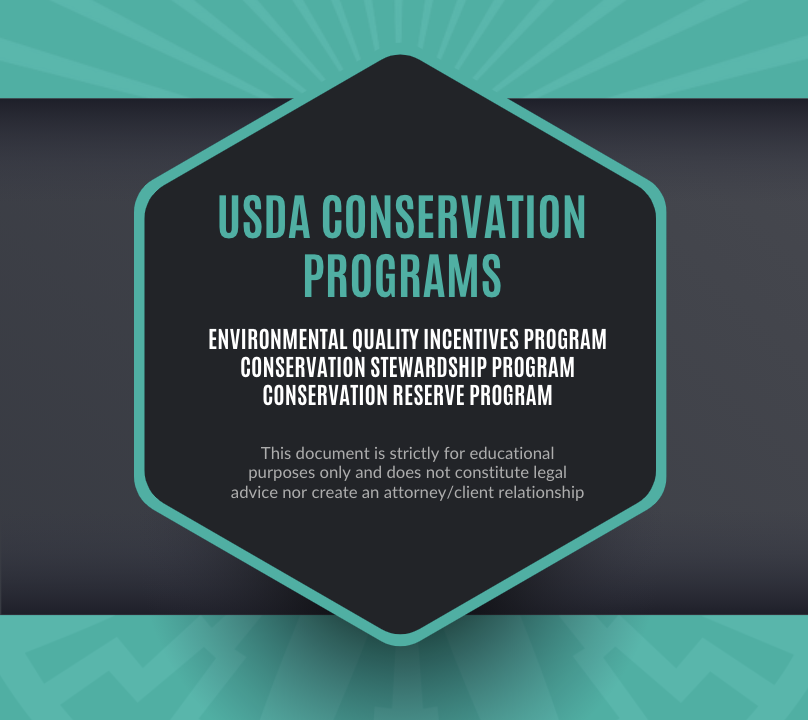This document is strictly for educational purposes only and does not constitute legal advice nor create an attorney/client relationship
The Environmental Quality Incentives Program (EQIP)
The Environmental Quality Incentives Program (EQIP) is a voluntary, working lands conservation program managed by the USDA Natural Resources Conservation Service(NRCS), offering farmers and ranchers financial cost-share and technical assistance to address natural resource concerns on their land. Through EQIP, producers implement practices to improve air and water quality, conserve ground and surface water, increased soil health and reduced soil erosion and sedimentation, improved or created wildlife habitat, and mitigation against drought and increasing weather volatility. Participants inEQIP install eligible conservation practices on agricultural land in exchange for financial cost-share and technical assistance through a contractual agreement for a term of three to ten years. This funding can be used for a variety of purposes, including conventional and organic, specialty crops and commodity crops, forestry and wildlife, historically underserved farmers, and livestock operations.
How to Access EQUIP
Enrollment in EQIP occurs on a rolling basis, but State Conservationists periodically rank applications and provide cyclical funding in accordance with state deadlines. Those eligible include farmers, ranchers, and forest landowners who rent or own agricultural land. While EQIP generally pays 75 percent of the costs for certain conservation practices, cost-share rates for socially disadvantaged, limited-resource, and beginning farmer and ranchers is up to 90 percent. Additionally, any individual falling within this aforementioned class of producers is eligible 50 percent advance payment of costs associated with planning, design, materials, equipment, installation, labor, management, maintenance, or training.
Information/Documents Needed to Apply for EQIP
Individuals may enroll in this program by reaching out to their local Natural ResourcesConservation Service office. You may locate your local office at: www.farmers.gov/service-center-locator
Conservation Stewardship Program (CSP)
The Conservation Stewardship Program (CSP) is a voluntary, working lands conservation program managed by the USDA Natural Resources Conservation, encouraging producers to address resource concerns in a comprehensive manner by improving, maintaining, and managing existing conservation activities and employing additional natural resource measures on productive and profitable farms. Individuals enrolled in CSP receive technical and financial assistance to conducting existing conservation measures and employing additional conservation practices on lands actively involved in agricultural production. Individuals enrolled in CSP receive payment through two methods as part of a five-year contract with USDA: annual payments for installing new conservation activities and maintaining existing practices or supplemental funding for adopting a resource-conserving rotational crop practice.
How to Access CSP
Eligible applicants for a CSP contract include individuals, legal entities, joint operations, or Indian tribes meeting the stewardship threshold for two federally designated resource concerns when they apply. Applicants must also agree to meet or exceed the stewardship threshold for at least one additional priority resource concern by the end of the contract. Additionally, the applicant must have control of the land for the term of the contract. Although applications are accepted on a rolling basis, the NRCS will typically rank applications on an annual basis and enter into contracts with selected applicants until funding for that period is expended. The NRCS gives special priority under CSP to beginning farmers to encourage enrollment in CSP and adoption of conservation measures on their farm. Under the 2018 Farm Bill, there is a five percent set aside CSP acres made available to beginning farmers and ranchers, and an additional five percent for socially disadvantaged producers. Competition for these funds will be for others falling into these respective categories – not with CSP applicants as a whole.
Information/Documents Needed to Apply for CSP
Individuals may enroll in this program by reaching out to their local Natural Resources Conservation Service office. You may locate your local office at: www.farmers.gov/service-center-locator
The NRCS typically announces each winter when they will be ranking applications and applicants then have a few months to submit their enrollment request.
Conservation Reserve Program (CRP)
The Conservation Reserve Program (CRP) is a voluntary program administered by the USDA Farm Service Agency (FSA), with technical assistance and implementation efforts provided by the USDA Natural Resources Conservation Service (NRCS). Under CRP, agricultural producers plant long-term, resource-conserving grasses or trees on environmentally sensitive farmland to improve the quality of water, control soil erosion, and enhance wildlife habitat. In exchange for conducting these practices and taking this farmland out of active production for a period of 10-15 years, FSA provides producers with rental payments and cost-share assistance.
How to Access CRP
Enrollment in CRP occurs two ways: General CRP Sign-Up and CRP Continuous Sign-Up. General CRP Sign-Up is a competitive process that is announced on a periodic basis by the Secretary of Agriculture with the enrollment period not adhering to any fixed yearly schedule, but the 2018 Farm Bill requires this sign up to occur at least once per year. Continuous CRP Sign-Up allows for land to be enrolled at any time as long as the parcel is environmentally sensitive land devoted to certain conservation practices. Subject to a few exceptions, a producer is generally eligible to enroll in CRP so long as they have owned or operated the land for at least 12 months before the first year of their CRP contract period. Two years prior to the expiration of a CRP contract, an individual may participate in the CRP Transition Incentives Program, which allows an underserved producer to begin making conservation or land improvements on the land covered by the CRP contract. Once this CRP contract comes near termination or expiration, the landowner can commence the process of transitioning his or her land to an underserved producer under CRP-TIP for that underserved producer to further participate in EQIP or CSP with the land previously under a CRP contract.
Information/Documents Needed to Apply for CRP
InIndividuals may enroll in this program by reaching out to their local Farm Service Agency office. You may locate your local office at: www.farmers.gov/service-center-locator

